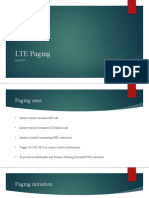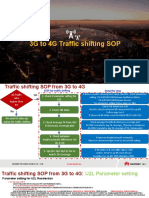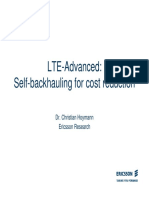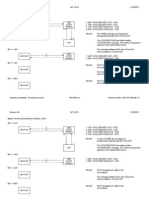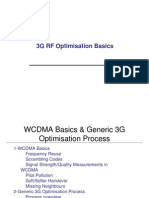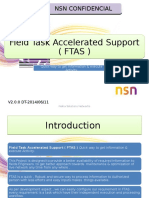LTE System Optimization
LTE System Optimization
Uploaded by
Navi NaviCopyright:
Available Formats
LTE System Optimization
LTE System Optimization
Uploaded by
Navi NaviOriginal Description:
Original Title
Copyright
Available Formats
Share this document
Did you find this document useful?
Is this content inappropriate?
Copyright:
Available Formats
LTE System Optimization
LTE System Optimization
Uploaded by
Navi NaviCopyright:
Available Formats
LTE eRAN6.
0 Scheduling Feature P-1
Confidential Information of Huawei. No Spreading Without Permission
LTE eRAN6.0 Scheduling Feature P-2
Confidential Information of Huawei. No Spreading Without Permission
Course Name P-3
Confidential Information of Huawei. No Spreading Without Permission
LTE eRAN6.0 Scheduling Feature P-4
LTE air interface scheduling is the responsibility of the eNodeB, however additional
scheduling and QoS (Quality of Service) handling could take place in the EPC (Evolved
Packet Core).
Typically, the main goal of scheduling is to meet the different users’ expectations.
Historically the radio interface is the “weak link” or “bottle neck” in the overall end-to-end
service. This is typically due to limited physical resources, i.e. limited bandwidth or channels.
The scheduling in previous systems, such as GSM and UMTS, was easier. This was due to
the fact that voice was the main service and required a dedicated channel. As such, the
number of channels (or elements) on the base station limited the number of simultaneous
calls.
The eNodeB implements scheduling at the Medium Access Control (MAC) layer and
provides time-and-frequency resources for uplink and downlink through scheduling. On
the premise of guaranteed Quality of Service (QoS), scheduling aims to transmit data on
the channel with better quality and maximize system throughput by using different
channel qualities among UEs.
Confidential Information of Huawei. No Spreading Without Permission
LTE eRAN6.0 Scheduling Feature P-5
Confidential Information of Huawei. No Spreading Without Permission
LTE eRAN6.0 Scheduling Feature P-6
Confidential Information of Huawei. No Spreading Without Permission
LTE eRAN6.0 Scheduling Feature P-7
The signaling required for scheduling downlink resources is firstly dependent on the type
of resources being scheduled. The LTE system defines various DCI (Downlink Control
Information). These enable both downlink and uplink scheduling, as well as linking to
different MIMO and diversity options.
Confidential Information of Huawei. No Spreading Without Permission
Course Name P-8
Confidential Information of Huawei. No Spreading Without Permission
LTE eRAN6.0 Scheduling Feature
Confidential Information of Huawei. No Spreading Without Permission
LTE eRAN6.0 Scheduling Feature P-10
Input of DL scheduler
UE Capability: It specifies eight UE categories and the maximum numbers of bits
and layers that can be transmitted in each TTI for each category
Channel quality indicator: Include CQI, PMI and RI report
HARP feedback: ACK and NACK feedback is another input to the scheduler. The
feedback indicates whether data is successfully transmitted or retransmitted. HARQ
retransmissions implemented by Huawei eNodeBs always have a high scheduling
priority
Confidential Information of Huawei. No Spreading Without Permission
LTE eRAN6.0 Scheduling Feature P-11
Confidential Information of Huawei. No Spreading Without Permission
LTE eRAN6.0 Scheduling Feature P-12
Confidential Information of Huawei. No Spreading Without Permission
LTE eRAN6.0 Scheduling Feature P-13
HARQ retransmissions are scheduled after control-plane messages. The scheduling
priorities of different HARQ retransmissions are determined by the wait time. A longer wait
time indicates a higher scheduling priority. If all retransmissions have the same wait time, a
retransmission is randomly selected. If discontinuous reception (DRX) is enabled, the wait
time is determined by the DrxReTxTimer parameter. If the wait time of an HARQ
retransmission exceeds a specified wait time, the HARQ retransmission is discarded.
Confidential Information of Huawei. No Spreading Without Permission
LTE eRAN6.0 Scheduling Feature P-14
DL scheduling performs three operations:
Selects UEs to be scheduled
Determine MCSs to be used
Determines the number and positions of RBs to be allocated.
Confidential Information of Huawei. No Spreading Without Permission
LTE eRAN6.0 Scheduling Feature P-15
Huawei eNodeB supports four scheduling strategies:
Max C/I
Round Robin (RR)
Proportional Fair (PF)
Enhanced Proportional Fair (EPF)
The downlink scheduling strategy is decided by the DlschStrategy parameter, and the
uplink scheduling strategy is decided by the UlschStrategy parameter.
With Max C/I, RR, and PF scheduling strategies, dynamic scheduling is used for all services.
With the EPF scheduling strategy, only the VoIP services use semi-persistent scheduling.
Confidential Information of Huawei. No Spreading Without Permission
LTE eRAN6.0 Scheduling Feature P-16
Prioritization of GBR Services
The following factors are weighted in the priority calculation of GBR services in Huawei
eNodeB:
Channel quality
The instantaneous channel quality of the UE is taken into account. The UE
with better instantaneous channel quality has a higher priority. In the case
of the same channel quality, the GBR service with QCI of 1 has a higher
priority than other GBR services.
Delay
The closer the waiting time of the first packet in the buffer is to the Packet
Delay Budget (PDB), the higher the priority is. The PDB value depends on
the QCI. For details, see reference document [5].
Relative priority
The prioritization of GBR services is different from that of non-GBR services.
This factor is added to compare the priority of GBR services with that of
non-GBR services.
Confidential Information of Huawei. No Spreading Without Permission
LTE eRAN6.0 Scheduling Feature P-17
Confidential Information of Huawei. No Spreading Without Permission
LTE eRAN6.0 Scheduling Feature P-18
Confidential Information of Huawei. No Spreading Without Permission
LTE eRAN6.0 Scheduling Feature P-19
Parameter Description
DlschStrategy Indicates the switch of the DL scheduling policy
NonGbrResourceRatio Indicates the proportion of resources reserved for non-GBR
services. A proportion of resources is reserved periodically to
prevent non-GBR services from failing to be allocated
resources. During the periods when resources are reserved,
resources are scheduled preferentially for non-GBR services. If
this parameter is set to 0, resources are not reserved for non-
GBR services.
DlEpfCapacityFactor Indicates the capacity factor for downlink enhanced
proportional fair (EPF) scheduling. This factor affects the
scheduling priorities of UEs running services with the QCI of 6,
7, 8, or 9, and accordingly can be used to adjust the cell
capacity and fairness among users.
Confidential Information of Huawei. No Spreading Without Permission
LTE eRAN6.0 Scheduling Feature P-20
Parameter Description
DlschPriorityFactor Indicates the weight factor used in the calculation of
connection priorities during downlink scheduling
DlMinGbr Indicates the downlink minimum guaranteed bit rate of the
non-GBR service.
Confidential Information of Huawei. No Spreading Without Permission
LTE eRAN6.0 Scheduling Feature
Confidential Information of Huawei. No Spreading Without Permission
LTE eRAN6.0 Scheduling Feature P-22
When a UE is handed over to a target cell, initially, the channel quality is poor and the UE
may not report CQIs timely. Therefore, to guarantee the data transmission performance
during this period, Huawei eNodeB sets a static MCS on the UE until the UE reports CQIs
stably. After this, if the UE reports valid CQIs, the system performs MCS selection
according to the previously mentioned procedure.
If part of resources in the RBs for scheduling are occupied by broadcast or synchronization
signals, the actual code rate in data transmission increases with the same TBS. In this case,
the eNodeB adjusts the MCS according to actual situations.
MCS to TBS mapping table
Confidential Information of Huawei. No Spreading Without Permission
LTE eRAN6.0 Scheduling Feature P-23
Example of mapping table
41 42 43 44 45 46 47 48 49 50
0 1128 1160 1192 1224 1256 1256 1288 1320 1352 1384
1 1480 1544 1544 1608 1608 1672 1736 1736 1800 1800
2 1800 1864 1928 1992 2024 2088 2088 2152 2216 2216
3 2408 2472 2536 2536 2600 2664 2728 2792 2856 2856
4 2984 2984 3112 3112 3240 3240 3368 3496 3496 3624
5 3624 3752 3752 3880 4008 4008 4136 4264 4392 4392
6 4264 4392 4584 4584 4776 4776 4968 4968 5160 5160
7 4968 5160 5352 5352 5544 5736 5736 5992 5992 6200
8 5736 5992 5992 6200 6200 6456 6456 6712 6968 6968
9 6456 6712 6712 6968 6968 7224 7480 7480 7736 7992
10 7224 7480 7480 7736 7992 7992 8248 8504 8504 8760
11 8248 8504 8760 8760 9144 9144 9528 9528 9912 9912
12 9528 9528 9912 9912 10296 10680 10680 11064 11064 11448
13 10680 10680 11064 11448 11448 11832 12216 12216 12576 12960
14 11832 12216 12216 12576 12960 12960 13536 13536 14112 14112
15 12576 12960 12960 13536 13536 14112 14688 14688 15264 15264
16 13536 13536 14112 14112 14688 14688 15264 15840 15840 16416
17 14688 15264 15264 15840 16416 16416 16992 17568 17568 18336
18 16416 16416 16992 17568 17568 18336 18336 19080 19080 19848
19 17568 18336 18336 19080 19080 19848 20616 20616 21384 21384
20 19080 19848 19848 20616 20616 21384 22152 22152 22920 22920
21 20616 21384 21384 22152 22920 22920 23688 24496 24496 25456
22 22152 22920 22920 23688 24496 24496 25456 25456 26416 27376
23 23688 24496 24496 25456 25456 26416 27376 27376 28336 28336
24 25456 25456 26416 26416 27376 28336 28336 29296 29296 30576
25 26416 26416 27376 28336 28336 29296 29296 30576 31704 31704
26 30576 30576 31704 32856 32856 34008 35160 35160 36696 36696
Confidential Information of Huawei. No Spreading Without Permission
LTE eRAN6.0 Scheduling Feature
Confidential Information of Huawei. No Spreading Without Permission
LTE eRAN6.0 Scheduling Feature
Confidential Information of Huawei. No Spreading Without Permission
Course Name P-26
Confidential Information of Huawei. No Spreading Without Permission
LTE eRAN6.0 Scheduling Feature
Confidential Information of Huawei. No Spreading Without Permission
LTE eRAN6.0 Scheduling Feature P-28
Uplink scheduling selects an appropriate UE at a proper time and allocates appropriate
resources on the PUSCH to the UE.
After the scheduling request from the UE is received, uplink scheduling is performed on the
UE, and MCS selection and RB allocation are performed on the basis of the current channel
quality of the UE, amount of data to be scheduled, and power headroom. In uplink
scheduling, the channel quality of the UE is indicated by the SINR measured at the physical
layer of the eNodeB. The amount of data to be scheduled depends on the Buffer Status
Report (BSR) reported by the UE. The power headroom depends on the Power Headroom
Report (PHR) reported by the UE.
Confidential Information of Huawei. No Spreading Without Permission
LTE eRAN6.0 Scheduling Feature P-29
Confidential Information of Huawei. No Spreading Without Permission
LTE eRAN6.0 Scheduling Feature P-30
Confidential Information of Huawei. No Spreading Without Permission
LTE eRAN6.0 Scheduling Feature P-31
Confidential Information of Huawei. No Spreading Without Permission
LTE eRAN6.0 Scheduling Feature P-32
The UE with the first transmission refers to the UE that needs to transmit msg3. These UEs
are scheduled in the order of msg3 transmission time. The UE with the first transmission
uses the resource allocation scheme of frequency non-selective scheduling. Four RBs are
allocated to a UE with the first transmission. In case of non-contention based random
access, IMCS = 1. In case of contention based random access, IMCS = 1 if group A is used or
IMCS = 5 if group B is used.
Confidential Information of Huawei. No Spreading Without Permission
LTE eRAN6.0 Scheduling Feature P-33
Confidential Information of Huawei. No Spreading Without Permission
LTE eRAN6.0 Scheduling Feature P-34
Confidential Information of Huawei. No Spreading Without Permission
LTE eRAN6.0 Scheduling Feature P-35
The scheduler use EFP to ensure the QoS for each service, show as below:
UL scheduler ensure the GBR for GBR service, if there is sufficient resource, then
meet PBR (prioritized bit rate), but can not more than MBR
The UL scheduler uses a best effort policy for non-GBR services and ensures only
the minimum GBR specified by the UlMinGbr parameter. If there is sufficient
resource, then meet PBR (prioritized bit rate), but the total non-GBR service rate
can not more than AMBR
Confidential Information of Huawei. No Spreading Without Permission
LTE eRAN6.0 Scheduling Feature P-36
Confidential Information of Huawei. No Spreading Without Permission
LTE eRAN6.0 Scheduling Feature P-37
The differentiation between services with different QCIs is achieved by setting the logical
channel priority. The parameters involved are PrioritisedBitRate,
LogicalChannelPriority. Their settings are delivered from the eNodeB to each UE in a
radio resource control (RRC) signaling message. The priorities of services with different
QCIs can be specified as required.
The logical channel priority can be set to a value in the range of 9 to 16. A larger value
indicates a lower priority
As defined in 3GPP specifications, the prioritized bit rate (PBR) of a logical channel can be
set to a value in the range of {0, 8, 16, 32, 64, 128, 256, infinity} in units of kbyte/s. The
UE scheduler guarantees prioritized bit rates of logical channels in descending order of
logical channel priority.
Confidential Information of Huawei. No Spreading Without Permission
LTE eRAN6.0 Scheduling Feature P-38
Parameter Description
UlschStrategy Indicates the switch of the UL scheduling policy
AdaptHarqSwitch Indicates the switch that is used to control whether to enable
or disable UL adaptive HARQ
PreAllocationBandwidth Indicates the ratio of the maximum bandwidth resources that the
Ratio uplink scheduler can allocate to preallocation UEs to the total
system bandwidth.
PreAllocationMinPeriod Indicates the minimum interval between two pre-allocations.
That is, the actual interval between two pre-allocations of one UE
must be longer than or equal to the value of this parameter.
PreAllocationSize Indicates the data amount pre-allocated to each user.
SmartPreAllocationDura This parameter specifies the duration of uplink smart
tion preallocation. If this parameter is set to 0, uplink smart
preallocation does not take effect.
UlEpfCapacityFactor Indicates the capacity factor for uplink enhanced proportional
fair (EPF) scheduling
Confidential Information of Huawei. No Spreading Without Permission
LTE eRAN6.0 Scheduling Feature P-39
Parameter Description
UlschPriorityFactor Indicates the weight factor used in the calculation of connection
priorities during uplink scheduling
UlMinGbr Indicates the uplink minimum guaranteed bit rate of the non-
GBR service
PreAllocationWeight Indicates the pre-allocation weight.
PrioritisedBitRate Indicates the prioritized bit rate of the logical channel. The UE
scheduler guarantees prioritized bit rates of logical channels in
descending order of logical channel priority.
LogicalChannelPriority Indicates the priority of the logical channel. The UE scheduler
guarantees prioritized bit rates of logical channels in descending
order of logical channel priority.
Confidential Information of Huawei. No Spreading Without Permission
LTE eRAN6.0 Scheduling Feature
Confidential Information of Huawei. No Spreading Without Permission
LTE eRAN6.0 Scheduling Feature P-41
Confidential Information of Huawei. No Spreading Without Permission
LTE eRAN6.0 Scheduling Feature P-42
Due to the impact of channel fading on signals, the SINR at the reporting time changes
significantly, compared with that at the scheduling time.
For the Huawei uplink scheduling algorithm, the SINR adjustment scheme is adopted to
adjust the SINR reported by the physical layer in order to correct the SINR measurement
errors. In this way, the measured IBLER value approaches the target IBLER value. The IBLER
target value is set using the SinrAdjustTargetIbler parameter.
The SINR adjustment function is controlled by a switch under the UlSchSwitch parameter.
Confidential Information of Huawei. No Spreading Without Permission
LTE eRAN6.0 Scheduling Feature P-43
Confidential Information of Huawei. No Spreading Without Permission
LTE eRAN6.0 Scheduling Feature P-44
Confidential Information of Huawei. No Spreading Without Permission
LTE eRAN6.0 Scheduling Feature P-45
Confidential Information of Huawei. No Spreading Without Permission
LTE eRAN6.0 Scheduling Feature P-46
Confidential Information of Huawei. No Spreading Without Permission
You might also like
- KPI Formula All VendorsDocument29 pagesKPI Formula All VendorsFazlee KanNo ratings yet
- Paging in 4G LTE NetworkDocument36 pagesPaging in 4G LTE Networkmaihuyhai100% (1)
- LTE Service KPIDocument102 pagesLTE Service KPIManuel_VINo ratings yet
- UL CoMP FeatureDocument4 pagesUL CoMP FeatureIrfaset SetNo ratings yet
- LTE PCI Planning GuideDocument34 pagesLTE PCI Planning GuideUzair Tanveer100% (6)
- PDSCH Power Configuration Tool - V1.4Document9 pagesPDSCH Power Configuration Tool - V1.4CesarNo ratings yet
- LTE TroubleshootingDocument44 pagesLTE Troubleshootingsumit100% (5)
- Multi-Carrier Layer Management StrategiesDocument54 pagesMulti-Carrier Layer Management StrategiesHarsh BindalNo ratings yet
- RIM (eRAN13.1 - 01) HuaweiDocument59 pagesRIM (eRAN13.1 - 01) HuaweiLuis Carlos Silva67% (3)
- Cs Core - Call FlowsDocument16 pagesCs Core - Call FlowsAhmad Hassan100% (1)
- OEO102040 LTE ERAN2.1 Scheduling Feature ISSUE 1.01Document74 pagesOEO102040 LTE ERAN2.1 Scheduling Feature ISSUE 1.01Daniel YulistianNo ratings yet
- LTE Parameter - Ue State HandlingDocument39 pagesLTE Parameter - Ue State HandlingSatria Wibowo100% (5)
- LTE Interoperability in Connection Mode (LTE-GU)Document152 pagesLTE Interoperability in Connection Mode (LTE-GU)Believer100% (2)
- SPD LTE RF Channel Troubleshooting Guide 20120718 A 1 0Document44 pagesSPD LTE RF Channel Troubleshooting Guide 20120718 A 1 0Ahmed GamalNo ratings yet
- LTE Power ControlDocument34 pagesLTE Power ControlBimal Jhariat100% (2)
- LTE Access Fault Diagnosis ISSUE2 00Document95 pagesLTE Access Fault Diagnosis ISSUE2 00CannaNo ratings yet
- 4 LTE ERAN6.0 Scheduling Feature ISSUE1.00Document61 pages4 LTE ERAN6.0 Scheduling Feature ISSUE1.00Saad M HajiNo ratings yet
- Lte Capacity MonitoringDocument20 pagesLte Capacity MonitoringRezaBachtiar100% (4)
- FDD LTE Call Drop Troubleshooting GuideDocument38 pagesFDD LTE Call Drop Troubleshooting GuideZoheb HamidNo ratings yet
- LTE Timing Advance PDFDocument6 pagesLTE Timing Advance PDFdtvt40No ratings yet
- Huawei Inter RAT HO OptimizationDocument23 pagesHuawei Inter RAT HO OptimizationNandhu NadhuNo ratings yet
- UMTS and LTE Dynamic Power Sharing (SRAN17.1 - 01)Document44 pagesUMTS and LTE Dynamic Power Sharing (SRAN17.1 - 01)freveco111No ratings yet
- TDD LTE KPI Optimization GuideDocument95 pagesTDD LTE KPI Optimization GuideCamilo Bazan HerediaNo ratings yet
- Deploying PDSCH Efficiency ImprovementDocument6 pagesDeploying PDSCH Efficiency ImprovementNizami Mammadaliyev100% (1)
- HUAWEI RAN Parameters SettingsDocument85 pagesHUAWEI RAN Parameters SettingsPakcik Kamal100% (1)
- Optimization Guidelines - CAPACITY Huawei - DRAFT2Document128 pagesOptimization Guidelines - CAPACITY Huawei - DRAFT2Phi FeiNo ratings yet
- LTE FDD Throughput CalculationsDocument8 pagesLTE FDD Throughput CalculationsMuhammad Ali KhalidNo ratings yet
- LTE Downlink Power Allocation PB - Pa - 28july2017Document4 pagesLTE Downlink Power Allocation PB - Pa - 28july2017Bobir ShomaksudovNo ratings yet
- SPD - eRAN12.1 - Automatic Congestion HandlingDocument36 pagesSPD - eRAN12.1 - Automatic Congestion Handlinghamidreza farzanianNo ratings yet
- 5 LTE ERAN6.0 Handover Feature ISSUE1.00Document75 pages5 LTE ERAN6.0 Handover Feature ISSUE1.00Saad M HajiNo ratings yet
- Huawei Solution Description of Pts 30mbps Everywhere PDFDocument12 pagesHuawei Solution Description of Pts 30mbps Everywhere PDFfahmi1987No ratings yet
- PAPB RevDocument12 pagesPAPB RevCayo RianNo ratings yet
- Carrier Aggregation InfographicDocument1 pageCarrier Aggregation InfographicrawatumedNo ratings yet
- LTE SINR Principle & OptimizationDocument12 pagesLTE SINR Principle & OptimizationBrahim YEKHLEFNo ratings yet
- MAC Vs IP ThroughputDocument1 pageMAC Vs IP ThroughputSSCVT Technical Team100% (1)
- Lte PRB & Lte BlerDocument1 pageLte PRB & Lte BlerAnil DwivediNo ratings yet
- 3G To 4G Traffic Shifting SOP: ConfidentialDocument7 pages3G To 4G Traffic Shifting SOP: Confidentialshashank.prajapati93890% (1)
- CQI Adjustment Based On BLER TargetDocument14 pagesCQI Adjustment Based On BLER TargetBettahar Mohamed100% (1)
- Throughput Problem Log Collection Guide - 7.0Document28 pagesThroughput Problem Log Collection Guide - 7.0Mohammad KamruzzamanNo ratings yet
- UMTS Multi-Carrier Strategy TrainingDocument25 pagesUMTS Multi-Carrier Strategy TrainingIshanWeera1982No ratings yet
- 04 - 4G - Parameter - Bearer ManagementDocument39 pages04 - 4G - Parameter - Bearer ManagementAgus WaliyudinNo ratings yet
- Overshooting AnalysisDocument12 pagesOvershooting AnalysisKim Kit ChinNo ratings yet
- Admission and Congestion Control (ERAN15.1 - 01)Document56 pagesAdmission and Congestion Control (ERAN15.1 - 01)waelq2003No ratings yet
- OEO106030 LTE ERAN3.0 Power Control Feature ISSUE1.00Document31 pagesOEO106030 LTE ERAN3.0 Power Control Feature ISSUE1.00Muhammad Turi100% (1)
- Huawei LTE Wireless Parameter AuditDocument64 pagesHuawei LTE Wireless Parameter AuditMuhammad UsmanNo ratings yet
- Huawei RAN FEGE Port Analysis Use Case v1.0 PDFDocument8 pagesHuawei RAN FEGE Port Analysis Use Case v1.0 PDFfaisal100% (1)
- Ps-Service Problem OptimizationDocument133 pagesPs-Service Problem OptimizationOladipupo SolomonNo ratings yet
- QoS Class Identifier - QCI LTEDocument3 pagesQoS Class Identifier - QCI LTEMuhammad RizkiNo ratings yet
- MOD CAMGTCFG (Modify Carrier Aggregation Management Configuration)Document21 pagesMOD CAMGTCFG (Modify Carrier Aggregation Management Configuration)Lintong AldironNo ratings yet
- Lte Capacity Management v0.1 MBNL EslDocument110 pagesLte Capacity Management v0.1 MBNL Eslsakshi kureley100% (2)
- Capacity ManagementDocument53 pagesCapacity ManagementMudassir Hussain100% (1)
- LTE eRAN2.1 Power Control Feature: Confidential Information of Huawei. No Spreading Without PermissionDocument39 pagesLTE eRAN2.1 Power Control Feature: Confidential Information of Huawei. No Spreading Without PermissionAhmed GamalNo ratings yet
- Multi Carrier Cell Re-Selection in LTEDocument7 pagesMulti Carrier Cell Re-Selection in LTEEast Prepost100% (1)
- SJ-20131203170829-006-ZXSDR UniRAN FDD-LTE Base Station (V3.20.30) Radio Parameters Reference - 558739Document341 pagesSJ-20131203170829-006-ZXSDR UniRAN FDD-LTE Base Station (V3.20.30) Radio Parameters Reference - 558739moslem100% (1)
- Lte V2Document117 pagesLte V2ajay_kangra100% (1)
- LTE Power ControlDocument20 pagesLTE Power Controlfrancis ikegwuNo ratings yet
- HSUPA 2msTTIDocument15 pagesHSUPA 2msTTIHwelmenNo ratings yet
- Parameter OPtimization 3G PDFDocument143 pagesParameter OPtimization 3G PDFAnonymous TTVlXoNo ratings yet
- Huawei WCDMA Load ControlDocument109 pagesHuawei WCDMA Load Controlmr_hemel2386100% (3)
- Nrcoverageanalysisfor700mhz 200525090240 PDFDocument18 pagesNrcoverageanalysisfor700mhz 200525090240 PDFNavi NaviNo ratings yet
- LTE-Advanced: Self-Backhauling For Cost Reduction: Dr. Christian Hoymann Ericsson ResearchDocument10 pagesLTE-Advanced: Self-Backhauling For Cost Reduction: Dr. Christian Hoymann Ericsson ResearchNavi NaviNo ratings yet
- Nokia: LTE Radio Parameters (RL60)Document6 pagesNokia: LTE Radio Parameters (RL60)Navi Navi100% (1)
- Microwave System DescriptionDocument16 pagesMicrowave System DescriptionNavi NaviNo ratings yet
- PDH Optical Fibre System OverviewDocument27 pagesPDH Optical Fibre System OverviewNavi NaviNo ratings yet
- LTE Phase 3 PDFDocument14 pagesLTE Phase 3 PDFNavi NaviNo ratings yet
- SDH ConceptsDocument26 pagesSDH ConceptsNavi NaviNo ratings yet
- Overview of MicrowaveDocument39 pagesOverview of MicrowaveNavi NaviNo ratings yet
- Optical Fibre CableDocument35 pagesOptical Fibre CableNavi NaviNo ratings yet
- FCOB Alarm Connection PDFDocument1 pageFCOB Alarm Connection PDFNavi NaviNo ratings yet
- 5G Iot Market - Industry Trends and Forecast To 2026: Market by Connection (Direct Connectivity, IndirectDocument5 pages5G Iot Market - Industry Trends and Forecast To 2026: Market by Connection (Direct Connectivity, IndirectNavi NaviNo ratings yet
- Lte MCS THPT Improvement Recomendation AprilDocument7 pagesLte MCS THPT Improvement Recomendation AprilNavi Navi100% (1)
- 5G Iot Market - Industry Trends and Forecast To 2026: Market by Connection (Direct Connectivity, IndirectDocument5 pages5G Iot Market - Industry Trends and Forecast To 2026: Market by Connection (Direct Connectivity, IndirectNavi NaviNo ratings yet
- Mobile Originated Call and Mobile Terminated Call in GSMDocument10 pagesMobile Originated Call and Mobile Terminated Call in GSMPierreNo ratings yet
- Inter-RAT Parameters MML Command Source RAT Target RATDocument4 pagesInter-RAT Parameters MML Command Source RAT Target RATrashedsobujNo ratings yet
- LTE - AID - BOUR - BMD - Feature AlgnmentDocument1 pageLTE - AID - BOUR - BMD - Feature AlgnmentSofiane KhelfaouiNo ratings yet
- Communication System Lecture 1-2 PDFDocument11 pagesCommunication System Lecture 1-2 PDFMahmod Ahmed Mahmod AlzubaidyNo ratings yet
- 3G Neighbor List PlanningDocument3 pages3G Neighbor List PlanningOlumide Omoworare100% (1)
- ECO Report 03Document96 pagesECO Report 03ahmedshah512No ratings yet
- MIMODocument6 pagesMIMOomer xavi888No ratings yet
- USSD Call FlowsDocument2 pagesUSSD Call FlowsMurly Rajendran100% (3)
- Parameter Management in EIR, HLR, and VLRDocument33 pagesParameter Management in EIR, HLR, and VLRtamnguyen29842764No ratings yet
- Basic 3G OptimizationDocument24 pagesBasic 3G OptimizationDodi Bellamy100% (1)
- Maharashtra Board of Technical EducationDocument8 pagesMaharashtra Board of Technical EducationSumant MalganNo ratings yet
- U900 Voice Layer TrialDocument4 pagesU900 Voice Layer TrialsamNo ratings yet
- Reseaux MobilesDocument48 pagesReseaux MobilesFaba KamburutaNo ratings yet
- Socidoc - Us Ericsson Mss Kpi FormulaeDocument13 pagesSocidoc - Us Ericsson Mss Kpi FormulaelikameleNo ratings yet
- Signal Processing in GSMDocument46 pagesSignal Processing in GSMMuti Ul BariNo ratings yet
- PC BtsDocument64 pagesPC BtsRaissa BailloNo ratings yet
- Field Task Accelerated Support (Ftas) Field Task Accelerated Support (Ftas)Document58 pagesField Task Accelerated Support (Ftas) Field Task Accelerated Support (Ftas)Nirdosh ChhasatiyaNo ratings yet
- BACHELOR of Technology IN Information Technology: On Third Generation (3G)Document44 pagesBACHELOR of Technology IN Information Technology: On Third Generation (3G)Tanu YadavNo ratings yet
- Chapter v4Document45 pagesChapter v4yomif tamiruNo ratings yet
- Lte Mod 1 & 2 NTSDocument30 pagesLte Mod 1 & 2 NTSDavid DvoskineNo ratings yet
- SACCH Multi-FramesDocument7 pagesSACCH Multi-FramesShaluaNo ratings yet
- 2G SMS FlowDocument37 pages2G SMS FlowShaharyar Khan100% (2)
- RRU BandsDocument15 pagesRRU BandsAdeel MunirNo ratings yet
- RNO Analysis Mate V1 01Document93 pagesRNO Analysis Mate V1 01Manik KapoorNo ratings yet
- Sub Ant 1 (LB/MB) : LB LFEM (SKY13716), 4.0 X 3.0Document53 pagesSub Ant 1 (LB/MB) : LB LFEM (SKY13716), 4.0 X 3.0Gideao AstunNo ratings yet
- RN31672EN30GLA1 - RANPAR Combined - Parameter - Configuration - v1.0 - RU40Document38 pagesRN31672EN30GLA1 - RANPAR Combined - Parameter - Configuration - v1.0 - RU40khanhnam0509No ratings yet
- Curr Mob Voucher PDFDocument3 pagesCurr Mob Voucher PDFyqwe1093No ratings yet

